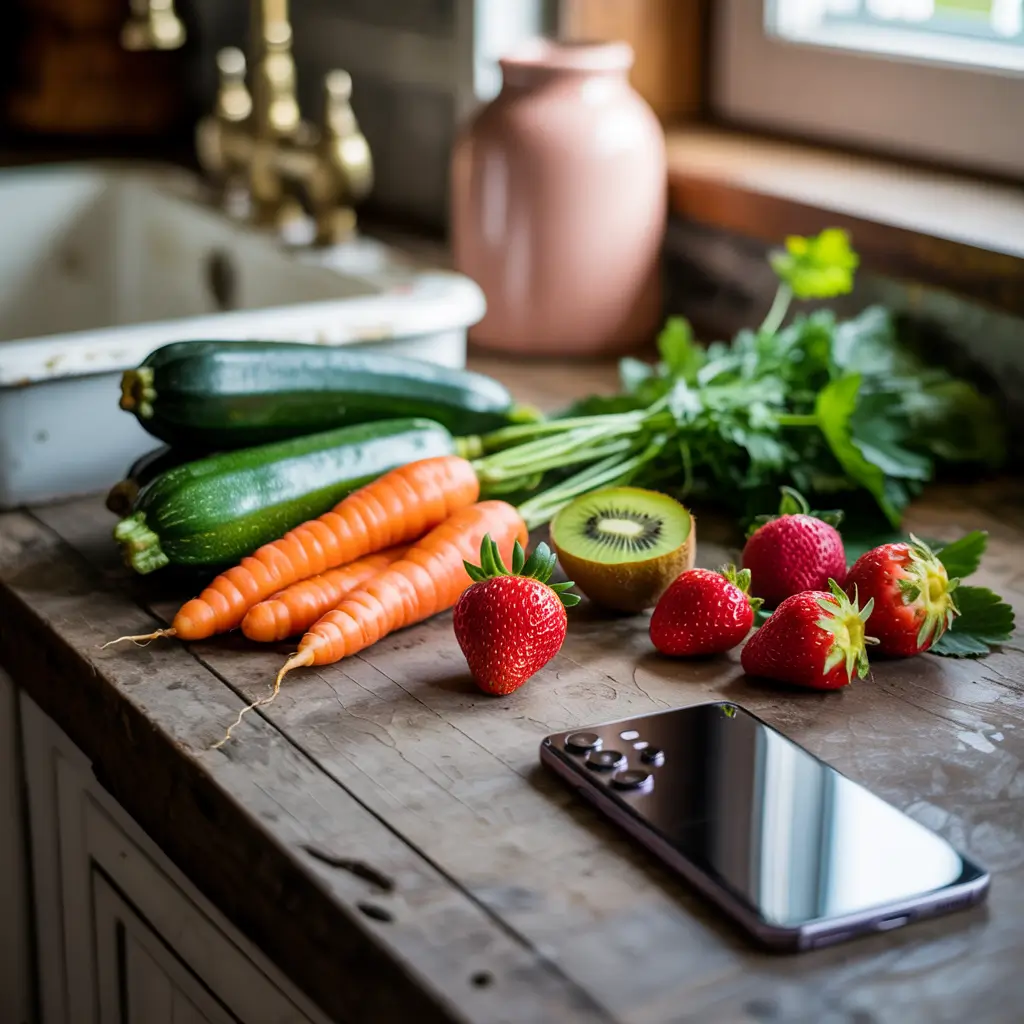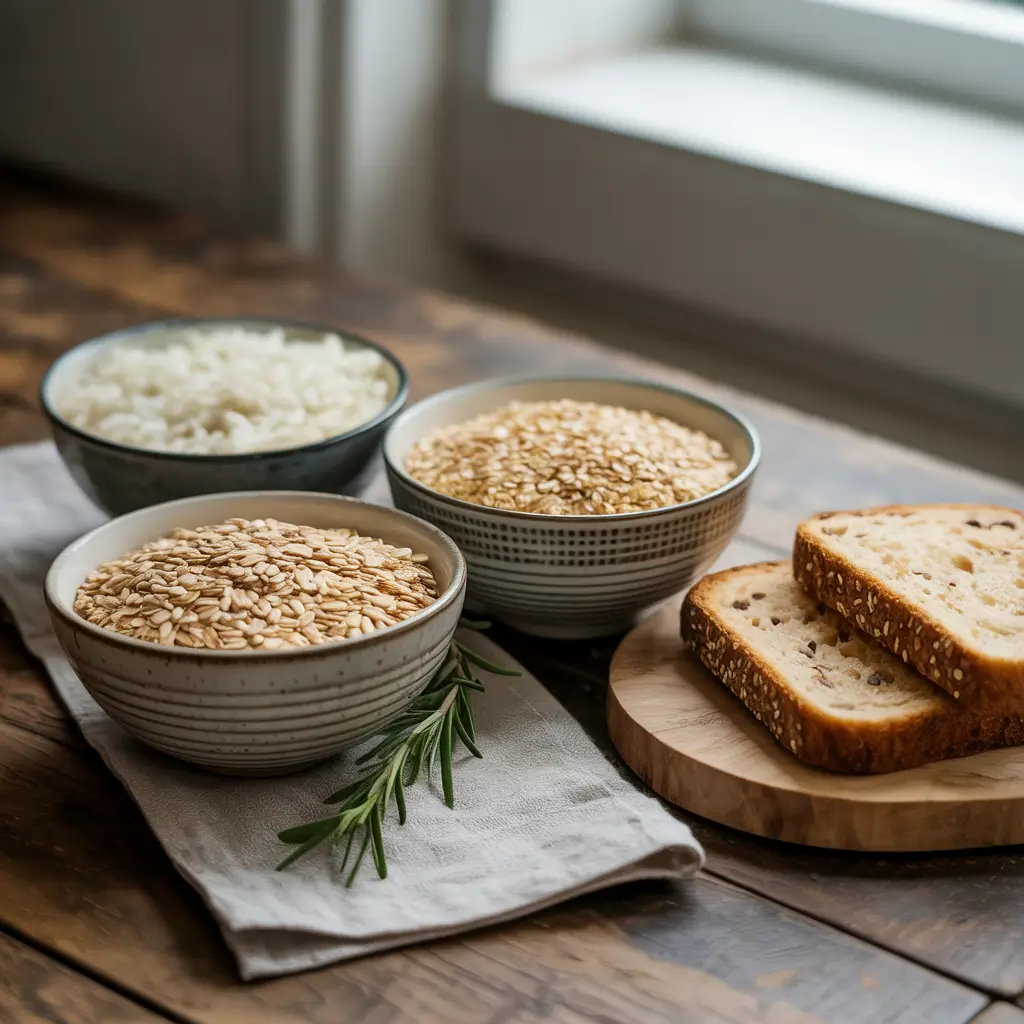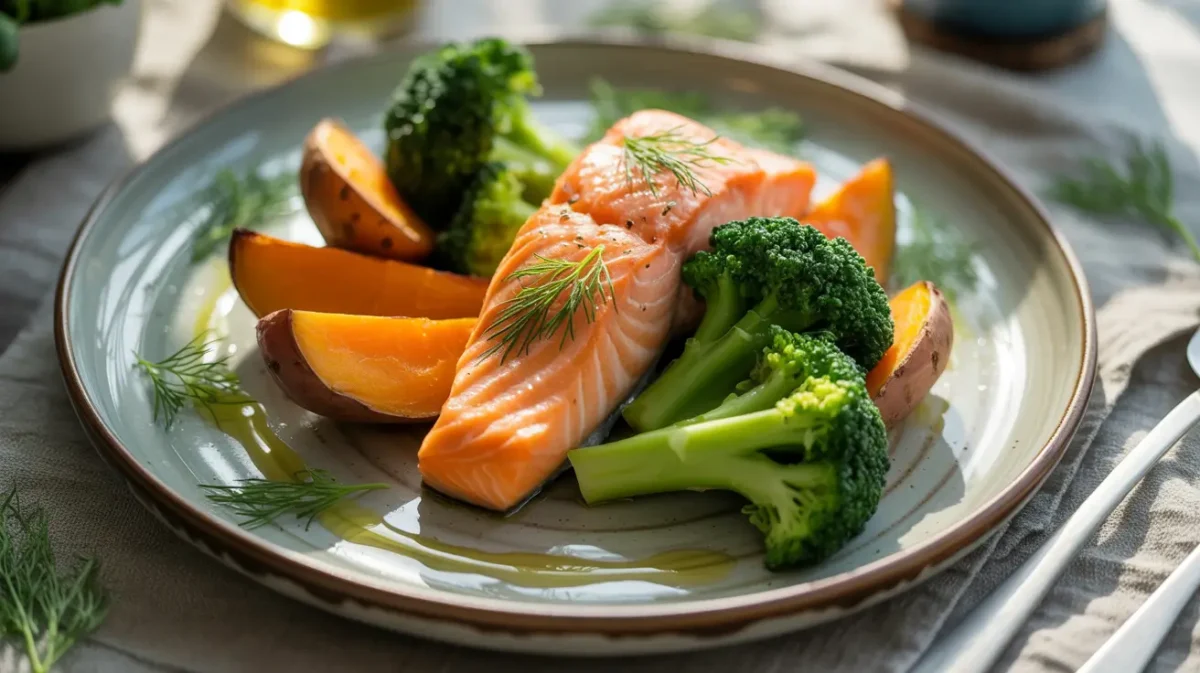introduction
Low FODMAP diet foods are essential for managing digestive issues like bloating, gas, and IBS. By cutting out fermentable carbs that irritate your gut, this diet helps reduce symptoms while still letting you enjoy flavorful meals.
In this guide, you’ll learn exactly what to eat, what to skip, and how to build a gut-friendly lifestyle—without feeling restricted.
Discover great ideas like Low FODMAP Diet Vegetarian Recipes – The Complete 2025 Guide for Gut-Friendly Eating.
Stay inspired—follow us on Facebook and Pinterest for more gut-friendly recipes.
Understanding Low FODMAP Diet Foods
What Is a Low FODMAP Diet and Why It Matters for Gut Health
Low FODMAP diet foods are designed to reduce digestive stress by eliminating specific short-chain carbohydrates that ferment in the gut. These carbs—fermentable oligosaccharides, disaccharides, monosaccharides, and polyols—can trigger symptoms like bloating, gas, abdominal pain, and irregular bowel movements, especially in individuals with IBS.
When you eat high FODMAP foods, your gut struggles to absorb them properly. This leads to fermentation by gut bacteria, which causes gas production and water retention in the intestines. That’s why many people feel immediate relief once they eliminate these trigger foods.
Originally developed by Monash University researchers, the Low FODMAP diet foods follows three phases: elimination, reintroduction, and maintenance. During the first phase, all high FODMAP foods are removed. In the second phase, foods are reintroduced one group at a time to identify your personal triggers. The final phase involves maintaining a diet that avoids only what your body can’t tolerate.
This isn’t just another diet trend—it’s a medically supported protocol that helps improve gut health and reduce inflammation over time. When done correctly, it brings lasting relief without sacrificing variety or nutrition.
Looking for inspiration? Try Japanese Pink Salt Ice Recipe for a refreshing, gut-friendly detox idea.
Categories of Low FODMAP Diet Foods

Vegetables and Greens That Are Low in FODMAPs
When it comes to low FODMAP diet foods, vegetables are one of your best allies—if you know which ones to pick. While many veggies contain fermentable fibers, others are naturally low in FODMAPs and easy on the gut.
Safe options include zucchini, spinach, kale, carrots, cucumbers, bell peppers, eggplant, and green beans. These can be grilled, roasted, or eaten raw without causing bloating or gas. Leafy greens like lettuce and arugula are also excellent choices and ideal for salads or sandwich toppings.
Just be cautious with portion sizes—some vegetables are only low FODMAP at smaller servings. Take pumpkin and butternut squash as an example — small portions are generally safe, but larger servings can quickly shift them into the high FODMAP category.
Fruits That Are Safe to Eat on a Low FODMAP diet foods
Not all fruits are gut-friendly, but there’s still a sweet selection you can enjoy. Strawberries, blueberries, kiwi, cantaloupe, oranges, pineapple, and unripe bananas are all low in FODMAPs when eaten in the right amounts.
Fruits like apples, pears, watermelon, and mango are high in fermentable sugars and should be avoided during the elimination phase. Instead, stick to fruits that are low in polyols and excess fructose.
Craving something refreshing? Don’t miss our Pink Salt Weight Loss Recipe for Women, a fruity detox drink that’s gentle on digestion.
Protein Sources and Meat Options in a Low FODMAP diet foods
Low FODMAP-Friendly Animal Protein Options
Many people assume a restricted diet means limited protein, but that’s far from the truth with low FODMAP diet foods. Most animal proteins are naturally free of FODMAPs, making them ideal for those managing digestive issues.
Chicken, turkey, beef, pork, eggs, and fish are all excellent choices—just watch out for added ingredients like garlic or onion in marinades or processed deli meats. Stick to plain, grilled, baked, or steamed versions, and avoid breaded meats unless the coating is low FODMAP certified.
Seafood like salmon, tuna, cod, and shrimp is also FODMAP-safe and packed with omega-3s, making it great for reducing gut inflammation. Eggs are versatile and completely FODMAP-free, so feel free to enjoy them scrambled, poached, or hard-boiled.
Plant-Based Proteins and Vegetarian Low FODMAP Foods
If you’re following a vegetarian or vegan diet, you’ll need to be a bit more selective. Many legumes—like lentils and chickpeas—are high in FODMAPs. However, you can enjoy firm tofu, tempeh, quinoa, canned lentils (drained), and hemp seeds in moderation.
Additionally, nut butters made from almonds or peanuts in small servings are generally well tolerated. These protein-rich plant options can form the base of satisfying, fiber-filled meals without triggering symptoms.
Be sure to check out our digestion-friendly Pink Salt Diet Recipe for Weight Loss—an ideal addition to your low FODMAP lifestyle
Grains, Cereals, and Bread You Can Eat for Low FODMAP diet foods

Gluten-Free vs. Low FODMAP diet foods: What You Need to Know
One of the biggest misconceptions about low FODMAP diet foods is that they’re the same as gluten-free. While both diets avoid certain grains, the reasons differ. The low FODMAP diet focuses on fermentable carbs, not gluten itself.
That said, many gluten-free products are low in FODMAPs, especially those made with rice, corn, oats, buckwheat, millet, or quinoa. But always check the labels—some gluten-free items contain high-FODMAP ingredients like inulin or chicory root, which can sneak in under “natural fibers.”
If you’re sensitive, it’s safer to choose certified low FODMAP bread and cereals or make homemade options using allowed grains.
Low FODMAP Whole Grains and Cereal Options
Looking for hearty carbs that won’t bloat your gut? There are several grain options that are both satisfying and FODMAP-safe. Rolled oats, brown rice, polenta, quinoa, and millet are excellent choices. They provide fiber and energy without triggering symptoms.
When it comes to breakfast cereals, go for unsweetened puffed rice, corn flakes, or oat-based granola with no dried fruit or honey. These are filling, versatile, and can be paired with lactose-free or almond milk for a complete morning meal.
Check out Pumpkin Pie Whoopie Pies for a unique dessert idea you can adapt to low FODMAP standards.
Dairy Alternatives and Low FODMAP Drinks
Low FODMAP Milk, Cheese, and Yogurt Substitutes
If you’re sensitive to lactose, traditional dairy products are off the table during the elimination phase. But don’t worry—many low FODMAP diet foods include safe, tasty dairy alternatives that won’t upset your gut.
For milk, go with lactose-free cow’s milk, almond milk (unsweetened), rice milk, or macadamia milk. Avoid oat and coconut milk in large servings as they can be high in FODMAPs depending on processing.
When it comes to cheese, hard-aged varieties like cheddar, parmesan, Swiss, and pecorino are typically low in lactose and easier to digest. Stick to small portions. For yogurt, choose lactose-free yogurt or those made from almond or coconut (in FODMAP-safe servings).
Beverages That Won’t Upset Your Stomach
Many drinks contain hidden FODMAP triggers like high-fructose corn syrup, apple juice, or artificial sweeteners. But you can still enjoy a wide variety of beverages safely.
Go for herbal teas, infused water, green tea, or plain coffee (without added creamers). Some fruit juices like cranberry or orange are fine in small servings if they don’t contain apple or pear concentrate.
Swap soda for a splash of citrus in sparkling water—it’s a crisp, tummy-friendly way to stay refreshed. Always read ingredient lists carefully to avoid hidden culprits.
Check out Whoopie Pies in Maine and consider modifying classic desserts with low FODMAP swaps.
Pantry Staples, Herbs, and Spices in a Low FODMAP diet foods Kitchen
Cooking Oils, Sauces, and Condiments That Are Safe
When stocking your pantry with low FODMAP diet foods, it’s important to review every label—especially for oils, sauces, and condiments. Plenty of packaged foods sneak in FODMAP culprits such as garlic, onion powder, or high-fructose corn syrup without you even noticing.
For cooking Low FODMAP diet foods, stick with pure oils such as olive oil, avocado oil, coconut oil, and canola oil. These are naturally free from FODMAPs and ideal for sautéing, roasting, or dressings.
Sauce-wise, look for low FODMAP-certified marinades, ketchup without high-fructose corn syrup, and tamari instead of regular soy sauce. You can also make your own condiments at home using gut-safe ingredients.
Low FODMAP pasta sauces are available, or you can whip up your own with diced tomatoes, basil, and a drizzle of garlic-infused oil (which contains flavor but not the FODMAP compound itself).
Herbs and Spices That Add Flavor Without FODMAPs
Flavor doesn’t have to suffer on a Low FODMAP diet foods. Many herbs and spices are completely safe and can transform your meals.
Use fresh or dried basil, oregano, thyme, rosemary, turmeric, cumin, coriander, chives, and parsley freely. Avoid garlic and onion powder unless they’re infused into oil (which is FODMAP-safe).
Salt, pepper, mustard seeds, and paprika are great for boosting taste without upsetting your gut. Start experimenting with homemade spice blends to take control of your seasoning game.
Easy Low FODMAP Meal Ideas & Recipe Inspiration

A Full Day of Delicious Low FODMAP Meals
Eating well on a low FODMAP diet doesn’t mean sacrificing flavor or creativity. With a few thoughtful substitutions, you can build balanced meals that are both tasty and gentle on digestion.
🌞 Breakfast
Start your day with a comforting bowl of rolled oats, topped with fresh strawberries, chia seeds, and a dollop of lactose-free yogurt. Sip on a warm cup of herbal tea or black coffee for a cozy, gut-friendly start.
🌿 Lunch
Whip up a vibrant salad using baby spinach, grilled chicken breast, shredded carrots, and cucumber slices. Add a splash of garlic-infused olive oil for bold flavor without triggering symptoms. Serve with quinoa or a slice of low FODMAP-friendly bread for extra fuel.
🌙 Dinner
Savor a plate of grilled salmon alongside oven-roasted zucchini and eggplant. Pair with creamy mashed potatoes—just skip the garlic and onion. A touch of lemon juice and chopped herbs elevates the dish naturally.
These meal ideas are packed with variety and designed to keep your digestion happy all day long.
Gut-Friendly Snacks & Sweet Treats
Snacking wisely helps maintain energy and keeps symptoms in check. Here are a few simple options:
- Rice cakes with smooth peanut butter
- Hard-boiled eggs
- A ripe kiwi or an unripe banana
- Lactose-free cheese with a few grapes
Desserts? Yes, please!
Treat yourself without the discomfort. Try:
- Coconut chia pudding with blueberries
- Banana oat cookies made with unripe bananas
- Fresh strawberries dipped in dark chocolate (in small portions)
✨ Need more inspiration? Check out our guide: Low FODMAP Diet Vegetarian Recipes – The Complete 2025 Guide for even more delicious ideas your gut will thank you for.
High vs. Low FODMAP diet foods List Table
Comprehensive Table Comparing High and Low FODMAP Foods
One of the easiest ways to follow the low FODMAP diet is by using a quick reference chart. Here’s a helpful table comparing high and low FODMAP diet foods to guide your grocery shopping and meal prep:
| Food Category | High FODMAP | Low FODMAP |
|---|---|---|
| Fruits | Apples, Pears, Watermelon, Mango | Strawberries, Kiwi, Oranges, Cantaloupe |
| Vegetables | Garlic, Onion, Cauliflower, Asparagus | Zucchini, Spinach, Carrot, Eggplant |
| Grains | Wheat, Rye, Barley | Oats, Quinoa, Rice, Millet |
| Dairy | Milk, Ice Cream, Yogurt (regular) | Lactose-free milk, Hard cheeses, Almond milk |
| Legumes | Lentils (raw), Chickpeas, Black beans | Firm tofu, Canned lentils (rinsed) |
| Sweeteners | Honey, High-fructose corn syrup | Maple syrup, Stevia (pure), Table sugar |
| Drinks | Apple juice, Soda, Beer | Water, Coffee (plain), Green tea |
This table helps you make smart substitutions and avoid common FODMAP traps.
Visual Guide to Elimination and Reintroduction Phases
The low FODMAP diet is structured into three clear phases:
- Elimination Phase: Cut out all high FODMAP foods completely for a period of 2 to 6 weeks to reset your gut.
- Reintroduction: Gradually reintroduce food groups to identify triggers.
- Maintenance: Customize a balanced plan based on your tolerance.
This method gives you control over your gut health without unnecessary restrictions. Keep a food journal during each phase to track symptoms accurately and adjust as needed.
Mistakes to Avoid on a Low FODMAP Diet
Common Errors That Sabotage Your Gut Health
Even with the best intentions, it’s easy to misstep when following a low FODMAP plan. One frequent misconception is that gluten-free automatically means low FODMAP. While they sometimes align, many gluten-free products still contain high FODMAP ingredients.
Another trap is underestimating hidden FODMAPs in condiments, sauces, or prepackaged snacks. Ingredients like onion powder, garlic extract, chicory root, or sugar alcohols (like sorbitol) often sneak into processed foods and trigger symptoms.
Portion control is another critical piece. Some low FODMAP diet foods become high FODMAP when eaten in excess. For example, butternut squash and canned lentils are gut-friendly in small servings but can cause bloating if overdone.
Lastly, staying in the elimination phase too long can backfire. It’s not meant to be permanent—reintroducing foods helps expand your diet, nourish your gut microbiome, and identify specific intolerances.
How to Read Food Labels and Avoid Hidden FODMAPs
Start by checking the ingredient list closely—look for garlic, onion, HFCS, inulin, agave, and sugar alcohols. Even a small amount of these can cause discomfort.
Also, be cautious with vague terms like “natural flavors” or “spices.” When in doubt, stick with certified low FODMAP products or prepare your meals from scratch using whole foods you trust.
Don’t miss our guide on Pink Salt Diet Recipe for Weight Loss for a clean-label, gut-friendly option.
FAQ Section
What food can you eat on a low FODMAP diet?
You can eat foods like rice, oats, carrots, cucumbers, zucchini, strawberries, eggs, and lactose-free dairy. These are all safe low FODMAP diet foods that support digestion.
What foods are no FODMAP?
Zero-FODMAP options include plain meats, eggs, oils, and herbs like basil or oregano. These are completely gut-safe and can be eaten freely.
What foods should I avoid on FODMAP?
Avoid garlic, onions, apples, wheat, lentils, and milk. These are high in fermentable carbs that often trigger digestive symptoms.
What are high and low FODMAP foods?
High FODMAP: apples, garlic, wheat.
Low FODMAP: spinach, firm tofu, oats.
Stick to low FODMAP diet foods to reduce bloating and discomfort.
Conclusion
Following a low FODMAP diet doesn’t mean sacrificing flavor or variety. With the right food choices, meal planning, and awareness of ingredients, you can reduce IBS symptoms, support your digestive health, and enjoy every bite along the way.
Remember, the key to success is knowing which low FODMAP diet foods work best for your body and gradually building a balanced, personalized eating plan. Keep learning, stay consistent, and enjoy the freedom of feeling better.
Don’t miss our guide on Japanese Pink Salt Ice Recipe for another gentle, refreshing idea.


1 thought on “Low FODMAP Diet Foods – The Complete 2025 Guide to Gut-Friendly Eating”
Comments are closed.